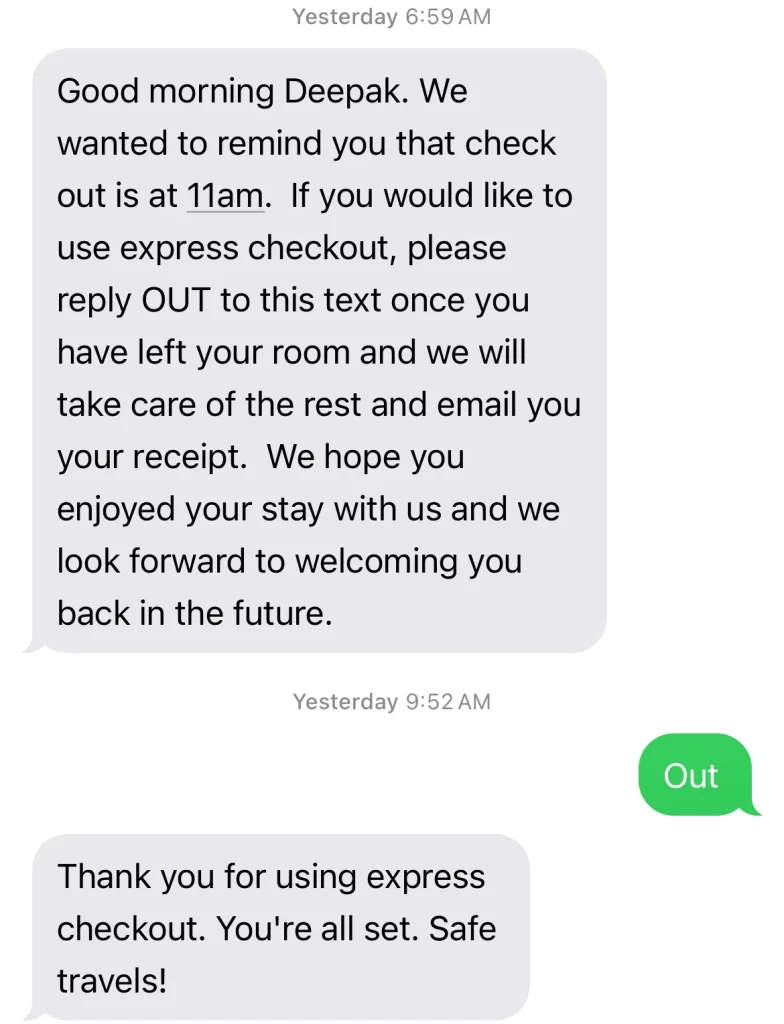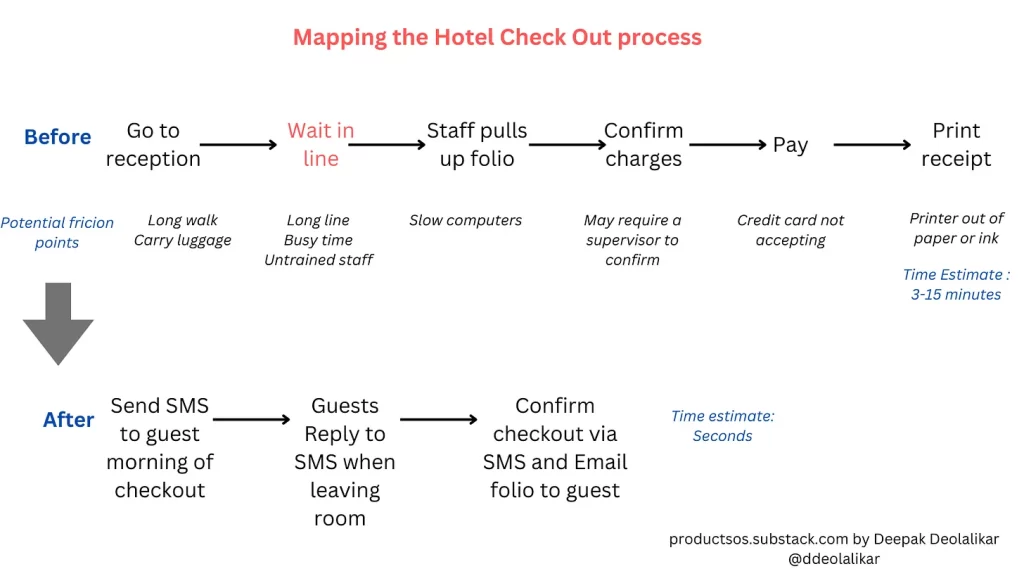Use jobs to be done framework
I was in Scottsdale, Arizona for a weekend getaway. We stayed at this large resort spanning multiple acres. You had to drive from your room to get to the reception area.
On Sunday we were to check out and I was dreading the experience.The traditional check out process at any hotel is archaic and cumbersome.
You walk to the reception. In my case, I would have to drive.
You stand in line, which can be a bit of a wait especially at peak times in popular locations.
When your turn comes, you wait for the staff to go through your charges.
They they will print out the bill. Usually, the printer is in a different locations. At times, they will run out of paper or even ink.
They you pay, sign the receipt.
An investment of 5-20 minutes.
Some hotels have improved the process especially for their frequent guests, but they still require you to download an app and sign in. Or go to the check out area and use a kiosk for self check out.
But this time I had a slightly different experience.
In the morning they sent me an SMS reminding me to check out. And once I leave the room, I should simply reply “out”.
Which I did when we left.
A response came back that I had checked out and a copy of the final bill will be emailed.
Done.

This was truly transformational. No standing in line. No waiting.
In order for this process to work, they needed my email, my phone number and a credit card which they gathered when I checked in. In fact, they had the email and phone when I had made the reservation through a travel site.
They could have eliminated the last step by defaulting the check out to say 11am. In other words, the guest could simply walk out.
Jobs to be done
In products, we use this framework called JTBD or Jobs to be done. In this framework, we map out what the user is trying to accomplish. In my case above, my job was to check out. There are no adjectives attached to the JTBD. e.g. my job is not a seamless check out or a smooth check out.
Just “check out”. How you provide the experience is next.
Other examples of JTBD in B2B could be :
Get help or support
Learn about products
Get training
Renew a subscription
Create a report
Create a new account entry (CRM)
Update opportunity record (CRM)
In each of these case, the user is trying to do something. We call these functional jobs.
Functional jobs are when your customers try to perform or complete a specific task or solve a specific problem as in the examples above.
But in addition to functional jobs, a user also has a social job and an emotional job.
Social Jobs: When your customers want to look good or gain power or status. These jobs describe how customers want to be perceived by others, for example, be considered a reliable employee who knows how to do their job.
Emotional Jobs: When your customers seek a specific emotional state, such as feeling good or secure. For example, achieving the feeling of job security at one’s workplace.
Lets’s imagine you are a PM for a CRM company and your user is a sales person.
What might be their jobs?
Functional: Close a sale, Do account reviews. Renew customers etc
Social Job: Become an accomplished sales rep who beats quota all the time and join the elite sales club.
Emotional Job: By consistently beating sales quota, a sales rep ensures job security and a fulfilling sense of purpose.
As a PM, when you design your product for this persona, you take into account all the jobs to be done and create product functionality accordingly.
The next step in this framework is to highlight everything a user has to do as part of their daily work. The process is laid out from a users perspective.
At each step identify any friction points and areas of improvement.
A helpful tool to use in this case is the “Before and After.”Map the process from a users perspective on how they do the job today. Then identify identify friction points in each of the steps.
Once you figure out the friction points, you can find solutions to eliminate.
Here is a simple illustration of the before and after of the check out process.

You may ask what if there are exceptions. For example, there is a wrong charge in the bill or the guests does not want to use the same credit card. Of course, the guests can go back to reception or email or call them.
But how often does that happen? If exceptions only happen rarely, then the processes should not be optimized for those scenarios. Rather, optimize them for the 80% of cases. Exceptions are always there in business and you can create processes around those.
Let me share a real life example of a product I launched a few years ago.
A sales person gets a cold lead via email. They have no other information about this lead. So they do some research about the person. Using Google, or other tools they try to find information about this person and the company. That way, they can have a meaningful conversation. The friction in this process is :
Takes too long to find information
Cannot access certain information
These sales people are on the clock as they have an SLA to respond to this lead soon, sometimes within minutes. The ideal solution was to automate the fact finding exercise so that the sales rep can have a meaningful conversation with the lead. This helps to improve the sales call and possibly reduce the sales cycle.
We created a product that gathered information from the external sources automatically. We partnered with other data providers who could also provide more information about individuals and companies. The product then packaged the information nicely and aided the conversation of the sales rep. So the cold lead is not a warm lead anymore.
There is even more opportunity to improve the process. What if AI could create talking points based on the information gathered. e.g. “based on recent news, the company where this prospect works expanded operations Europe and may be impacted by data privacy. Consider talking about the new data privacy check up tool”.
Conclusion
As a product manager, our goal is to transform our users life and allow them to perform their tasks with the least effort. It is imperative to understand the jobs to be done of your user personas and map the before/after processes. Remember, that users want to solve their pain points but only if they are effortless and friction free.

